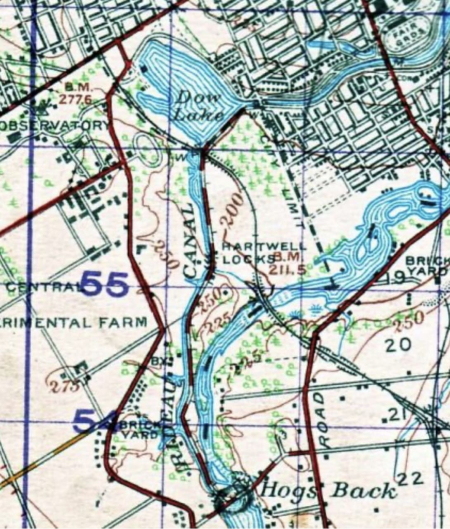Most of us think of “Dow’s Swamp” as having disappeared during the construction of the Rideau Canal, two centuries ago, leaving us with what we know today as “Dow’s Lake”.
But did you know that a remaining southern portion of Dow’s Swamp continued to thrive until Ottawa’s ever-expanding urban footprint brought about the final destruction of this vital and vibrant vestige of wetland in the 1950s?
Long-time naturalist and plant ecologist Joyce Reddoch reminds us of our tragic loss of that precious remnant of primaeval ecosystem, as is illustrated in the attached collection of articles, including a post-mortem of her own, published in a journal of the Ottawa Field Naturalists’ Club almost a half century ago.
Scientific studies show that this now-gone swamp – a low trough between Dow’s Lake and the Rideau River, bounded on the west by the old CPR track and on the east by the old Bronson Avenue – was a lake from about 7,000 until about 3,000 years ago when bog and swamp forest began to form, finally becoming tree-covered 1,000 to 1,500 years ago.
(A swamp is generally a wetland or peatland with standing water or water gently flowing through pools or channels. The water is rich in nutrients and the vegetation is characterized by a dense cover of deciduous or coniferous trees and shrubs, herbs and mosses. Oft-misunderstood and underappreciated, our swamps are crucial to maintaining biodiversity.)
John MacTaggart, Colonel By’s chief engineer observed of Dow’s Swamp in 1829 that “the cedar-trees… grow as thickly in the swamp as they possibly can grow, an average fourteen inches thick and seventy feet high”.
In the century+ old Ottawa Field Naturalists’ Club’s earlier days, this remaining southern remnant of Dow’s Swamp was cherished as a seemingly inexhaustible refuge for sightings of rare and flourishing flora and fauna, including rare and endangered orchids, rare butterflies, birds and frogs and other wildlife.
The terrain of Dow’s Swamp, as it still existed earlier last century, was well-described by renowned Canadian forester/zoologist C.H.D. Clarke as he noted the birds he had spotted “there, among the cedars, willows, alders and elms, in tangled glades that led over sodden ground to beds of cattails”.
More than a dozen species of native orchids had been excitedly recorded in this now-disappeared remnant of the Dow’s Swamp wetland complex. Alder flycatchers, Lincoln's sparrows, white-throated and clay-coloured sparrows, rusty blackbirds, ruby-crowned kinglets, veeries, vireos, scarlet tanagers, waterthrushes, warblers, Carolina and marsh wrens, purple finches and black ducks were among the sometimes-scarce birds that Dr. Clarke and other avid naturalists would add to their observation lists.
Through these attached articles, Dr. Reddoch invites us to better understand that swamps, in their undamaged state, are ecosystems crucial to the maintenance of ecological diversity (and for maintaining ground water levels) – not dismal, stagnant, fetid places as per our popular misconceptions.
(Even mosquitoes – such as those who had likely persuaded the Dow family to abandon their allotment in 1826 – perform crucial roles as plant pollinators and food for birds.)
Dow’s Swamp is a lost ecological gem that Joyce Reddoch urges us never to forget.
(As we mourn the loss of this one small urban-enclosed portion of primaeval wilderness, one can only reflect on the impact post-contact settlement has had across our nation, not only on the long-existing flora and fauna, but also on the Indigenous people, upon this land their lives and livelihoods had vitally depended.)
Here are the articles that Joyce has kindly provided for us to read and learn more:






